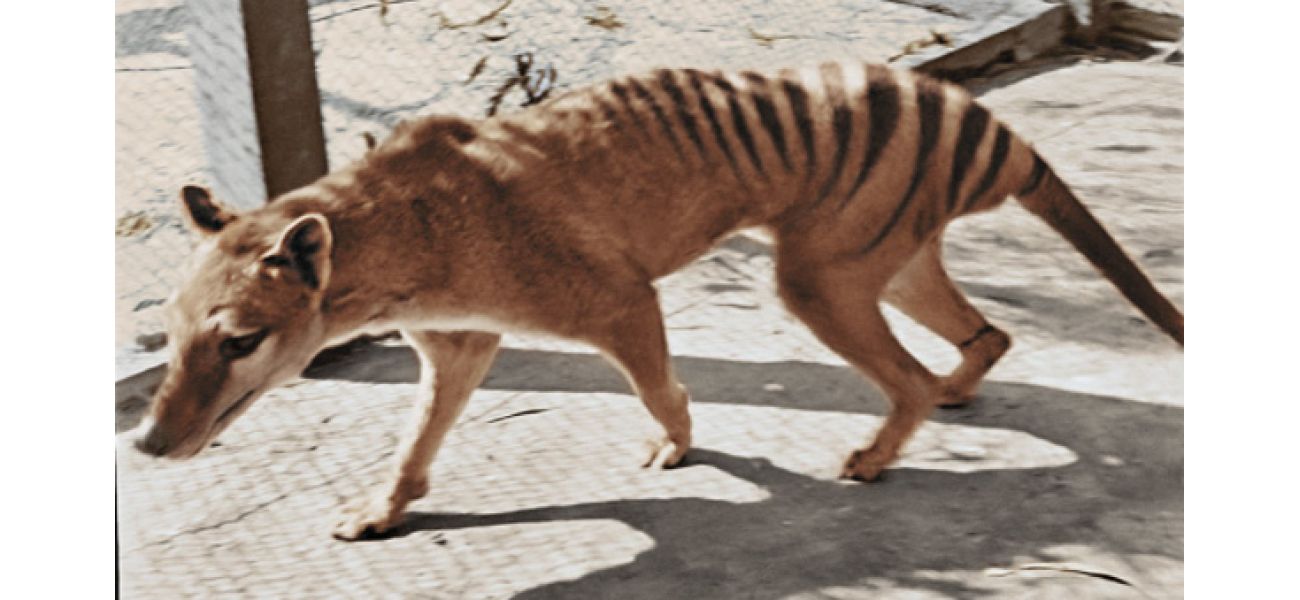Efforts to revive extinct Tassie tigers are progressing.
New findings reveal nearly identical DNA blueprint for Aussie thylacine, a breakthrough in research on the extinct marsupial.
October 17th 2024.

Australia is making strides towards bringing back a species that was thought to be long gone - the Tasmanian tiger. Through groundbreaking research on this iconic marsupial, scientists have managed to uncover an incredibly accurate genomic DNA blueprint for the tigers. These magnificent creatures were declared extinct in 1936, but researchers from Texas and Melbourne have recently announced that they have made "astonishing scientific progress" in recreating ancient DNA cells.
The team at the bioscience company Colossal has managed to achieve a 99.9% accuracy rate on the thylacine genome, a remarkable feat that has never been accomplished for an extinct species before. This is something that many experts believed would never be achieved. According to Beth Shapiro, Colossal's Chief Science Officer and the Director of the UCSC Paleogenomics Lab, this was made possible thanks to the exceptional preservation of the thylacine samples used for the reference genome. She says it is rare to have such well-preserved samples that allow for such groundbreaking research.
"We have delivered a record-breaking ancient genome that will greatly accelerate our thylacine de-extinction project," Shapiro added. This achievement was made possible in part thanks to DNA and soft tissue taken from a 110-year-old Tasmanian tiger. The head of this historic animal was completely preserved, allowing scientists to extract samples from major DNA hubs such as the tongue, brain, eye, and nasal cavities.
One of the distinctive features of the Tasmanian tiger was its jaw and skull shape, which bears a striking resemblance to that of wolves and dogs. Sara Ord, Director of Species Restoration at Colossal Biosciences, says they were thrilled to discover that these regions of the genome are indeed influencing the craniofacial phenotype as predicted. She believes this is crucial evidence of the effectiveness of Colossal's approach and a significant step towards thylacine de-extinction.
Dr. Andrew Pask, head of the research at the University of Melbourne, says they are getting closer and closer to reintroducing the Tasmanian tiger back into the ecosystem. "It's truly amazing to see how these new technologies are already being used to address major conservation issues for marsupials, as well as achieving all our major milestones for bringing back the thylacine," Dr. Pask added.
In a groundbreaking achievement, the team has also managed to take fertilized single-cell embryos and grow them halfway through pregnancy in an artificial uterus. This is a significant step that has never been achieved before for any marsupial. The thylacine disappeared from most parts of the world about 2000 years ago, with the exception of Tasmania. The last known thylacine living in captivity, named Benjamin, sadly passed away in 1936 at the Beaumaris Zoo in Hobart.
Overall, the progress made in bringing back the Tasmanian tiger is truly remarkable and has given hope to many conservation efforts. With the help of advanced technologies and dedicated researchers, we may soon see these majestic creatures back in their natural habitat once again.
The team at the bioscience company Colossal has managed to achieve a 99.9% accuracy rate on the thylacine genome, a remarkable feat that has never been accomplished for an extinct species before. This is something that many experts believed would never be achieved. According to Beth Shapiro, Colossal's Chief Science Officer and the Director of the UCSC Paleogenomics Lab, this was made possible thanks to the exceptional preservation of the thylacine samples used for the reference genome. She says it is rare to have such well-preserved samples that allow for such groundbreaking research.
"We have delivered a record-breaking ancient genome that will greatly accelerate our thylacine de-extinction project," Shapiro added. This achievement was made possible in part thanks to DNA and soft tissue taken from a 110-year-old Tasmanian tiger. The head of this historic animal was completely preserved, allowing scientists to extract samples from major DNA hubs such as the tongue, brain, eye, and nasal cavities.
One of the distinctive features of the Tasmanian tiger was its jaw and skull shape, which bears a striking resemblance to that of wolves and dogs. Sara Ord, Director of Species Restoration at Colossal Biosciences, says they were thrilled to discover that these regions of the genome are indeed influencing the craniofacial phenotype as predicted. She believes this is crucial evidence of the effectiveness of Colossal's approach and a significant step towards thylacine de-extinction.
Dr. Andrew Pask, head of the research at the University of Melbourne, says they are getting closer and closer to reintroducing the Tasmanian tiger back into the ecosystem. "It's truly amazing to see how these new technologies are already being used to address major conservation issues for marsupials, as well as achieving all our major milestones for bringing back the thylacine," Dr. Pask added.
In a groundbreaking achievement, the team has also managed to take fertilized single-cell embryos and grow them halfway through pregnancy in an artificial uterus. This is a significant step that has never been achieved before for any marsupial. The thylacine disappeared from most parts of the world about 2000 years ago, with the exception of Tasmania. The last known thylacine living in captivity, named Benjamin, sadly passed away in 1936 at the Beaumaris Zoo in Hobart.
Overall, the progress made in bringing back the Tasmanian tiger is truly remarkable and has given hope to many conservation efforts. With the help of advanced technologies and dedicated researchers, we may soon see these majestic creatures back in their natural habitat once again.
[This article has been trending online recently and has been generated with AI. Your feed is customized.]
[Generative AI is experimental.]
0
0
Submit Comment





